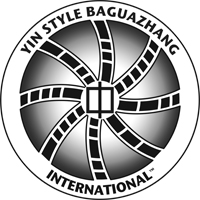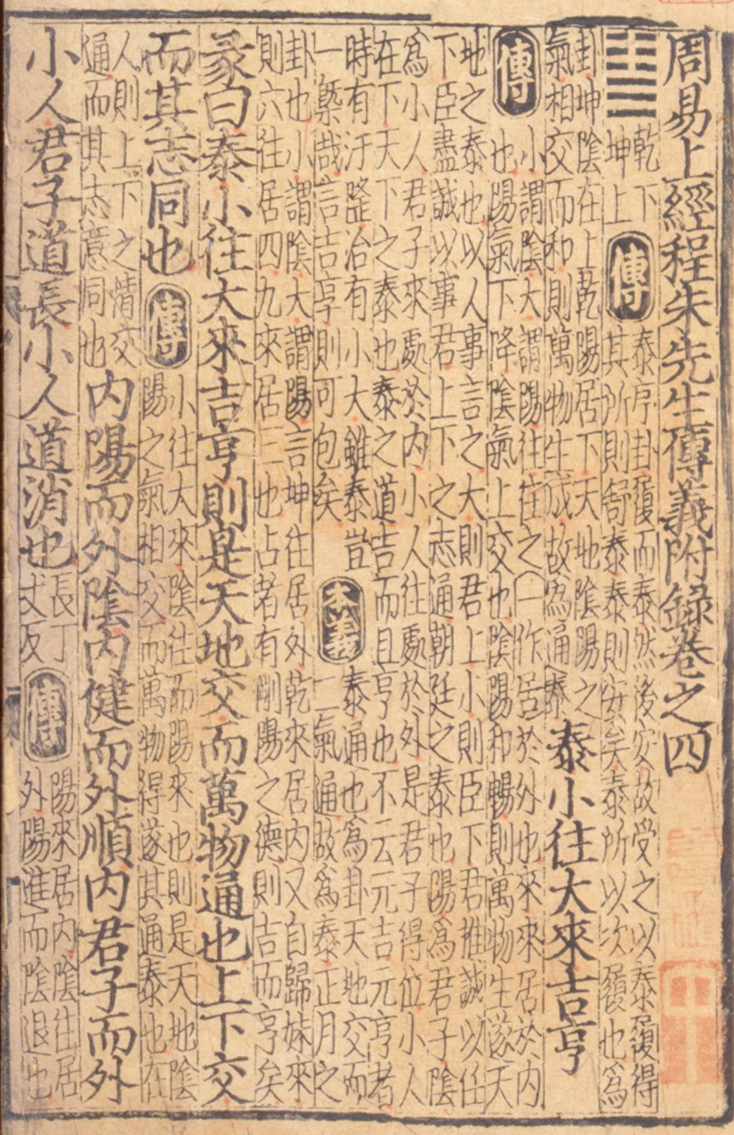 Originating in the Western Zhou period and with a history of over 2,500 years of commentary and use, the Book of Changes (周易 - Zhōuyì
) is the oldest classic text in Chinese civilization. As the ancients observed patterns of change in nature, they developed a way to describe and predict these changes using images of solid (positive, firm) and broken (negative, yielding) lines arranged in eight groups of three, known as the Eight Trigrams (八卦 - bāguà): ☰ ☵ ☶ ☳ ☴ ☲ ☷ ☱ These trigrams represent archetypes of all the possible phenomena of the world. Importantly, the trigrams themselves are not static objects or entities, but are used to show continuous transition from one to the next just as phenomena of the physical world undergo continual change from one state into the next. Through describing and helping us to understand the mechanism behind change, the Book of Changes attempts to give us the tools needed to adapt to circumstances in our lives and to judge whether a given course of action will bring success or failure.
Originating in the Western Zhou period and with a history of over 2,500 years of commentary and use, the Book of Changes (周易 - Zhōuyì
) is the oldest classic text in Chinese civilization. As the ancients observed patterns of change in nature, they developed a way to describe and predict these changes using images of solid (positive, firm) and broken (negative, yielding) lines arranged in eight groups of three, known as the Eight Trigrams (八卦 - bāguà): ☰ ☵ ☶ ☳ ☴ ☲ ☷ ☱ These trigrams represent archetypes of all the possible phenomena of the world. Importantly, the trigrams themselves are not static objects or entities, but are used to show continuous transition from one to the next just as phenomena of the physical world undergo continual change from one state into the next. Through describing and helping us to understand the mechanism behind change, the Book of Changes attempts to give us the tools needed to adapt to circumstances in our lives and to judge whether a given course of action will bring success or failure.
Just as change is the essence of the Book of Changes, so it is in Baguazhang, the combative art that was inspired by this classic.
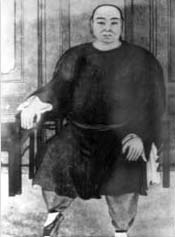 Dong Haichuan (Oct. 13, 1804 - Dec. 15, 1880) had a strong interest in the martial arts since his time growing up in Zhujiawu village, Wen'an county, just south of Beijing. As a youth, he first began training Six Harmony Fist from a man named Cangzhou Li. With an upright disposition and an innate hatred of evil, Dong Haichuan was the type to give assistance at the first sight of injustice. At the age of 18, while trying to mediate a dispute, words escalated into violence and he ended up getting into a fight. Upon returning home to a berating from his parents, he left his village in a fit of anger, setting out to wander and seek out famous martial arts teachers.
Dong Haichuan (Oct. 13, 1804 - Dec. 15, 1880) had a strong interest in the martial arts since his time growing up in Zhujiawu village, Wen'an county, just south of Beijing. As a youth, he first began training Six Harmony Fist from a man named Cangzhou Li. With an upright disposition and an innate hatred of evil, Dong Haichuan was the type to give assistance at the first sight of injustice. At the age of 18, while trying to mediate a dispute, words escalated into violence and he ended up getting into a fight. Upon returning home to a berating from his parents, he left his village in a fit of anger, setting out to wander and seek out famous martial arts teachers.
Dong first went to Henan, where during a brief stay he found that he could make an income from martial art street performance. Next he wandered to Jiangxi, losing his way deep in the mountains and coming to the where he saw two Daoist monks practicing. Dong noticed that they were quite old with white hair, but their faces looked like those of much younger men. Their movement was incredibly lively and Dong knew that they had special skill. He decided that he wanted to learn from them and approached on the pretense of asking the name of the mountian they were on. He then said that he wanted to learn martial arts from them. Initially reluctant, they relented and took him on as their student. Bringing him back to their monastery, the Jade Emperor Temple (玉皇观 - Yù Huáng Guān), Dong asked them their names and ther reply was "don't ask." The martial art they taught him was based on the Book of Changes, known as "Swimming Body Bagua Interlocking Palm" (游身八卦連環掌 - yóu shēn bāguà liánhuán zhǎng) - now commonly known as bāguàzhǎng - "Eight Trigram Palm". Dong's foundational first three years of training consisted of only circle turning practice with the penetrating palm. In total, he stayed with the two Daoists for 15 years. At the end of his time there, they told him, “you are now 33 years old and have very good skill; it's time for you to leave the mountain." Dong replied that he would rather stay on the mountain with them. They ordered him to leave, told him to behave himself and gave him the task of establishing bagua as a martial style.
Dong Haichuan left and then went to Suzhou where he heard of two very corrupt government officials who were doing a great deal of harm to the people there. He ended up finding and killing them both in the night. The news of their killing became well-known, so Dong knew he had to leave Suzhou. He went to Kaifeng in Henan where he stayed for ten years teaching martial arts and building quite a local reputation. Meanwhile, as the search for the killer of the two officials continued, suspicion arose in Kaifeng that it may have been Dong Haichuan. Subsequently, he left Kaifeng, looking to go to Beijing to become a eunuch. This he believed would keep him safe from being hunted down for killing the officials. At this point, Dong was already 50 years old.
Upon arrival in Beijing, he found an unused Buddhist temple tucked away on a large estate ground and thought he could stay and hide out there. The estate had a caretaker named He Liu who discovered Dong staying in the temple. Dong told He Liu his situation and upon hearing the story, He felt sympathy for Dong while at the same time admiring his martial skill. He Liu took Dong Haichuan to see Si Ye, the nobleman who owned the estate. On meeting Dong, Si Ye offered him a job handling security for the estate. Dong's skill was so impressive that the man initially responsible for Si Ye's security gave up the job.
Si Ye had a younger brother, Qi Ye, who wanted to test if Dong Haichuan's ability was really what it was supposed to be. One day, Qi Ye hid behind a doorway, holding a spear and waiting for Dong Haichuan to pass by. When Dong came through the doorway, Qi Ye stabbed at Dong with the spear, which Dong easily avoided. This angered Qi Ye, who pressed the attack. Dong continued evading the spear thrusts so skillfully that his clothes were not even touched. Si Ye happened to see this and stopped Qi Ye, admonishing him. After this, word of Dong Haichuan's skill spread and Si Ye sent him to see Prince Su who was a martial art enthusiast. The prince wanted to test Dong's skill, but Dong Haichuan had reservations about having a fight contest with a royal. Prince Su insisted and came at Dong with a fierce attack. Dong allowed the prince to attack freely while evading his strikes. The Prince realized that Dong was not even bothering to counterattack and was able to skillfully evade everything that was thrown at him. Prince Su asked Dong if he wanted to stay at his palace. Dong wanted to stay but felt obligated to Si Ye. Prince Su sent word to Si Ye that Dong Haichuan would be working for him. Now at the palace of Prince Su, Dong Haichuan's reputation began to grow around Beijing.
A martial arts practitioner named Yin Fu heard of Dong's reputation and went looking for him. Upon meeting Dong, Yin Fu told him that he had heard a great deal about his skill and wanted to learn from him. Dong Haichuan suspected that Yin's true motive was to fight, and as he approached they began to fight. Dong struck him three times, knocked him down and had Yin seeing stars. Yin Fu stayed down on the ground and asked Dong to accept him as his student, which he did. Afterward, Dong Haichuan began taking on many other students in Beijing.
After Dong had been at Prince Su's palace for a number of years, the prince came to him one day to tell him of something he needed done. The prince owned a large amount of land in Inner Mongolia where he had not collected rent for many years. He wanted to send Dong to do the difficult task of collecting this money. Dong Haichuan packed his belongings, took Yin Fu and about ten other people and set out. Dong stayed on quite a while performing this collections job for the prince as it turned out to be a great deal of work. Dong Haichuan would stay on site managing the colections while Yin Fu would go back and forth to Beijing, transporting the payments to Prince Su.
After ten years of this, Dong Haichuan returned to Beijing. By this time, Prince Su had already died and Dong was getting advanced in years. He retired from his work at the palace and went to live with a student named Shi Ji Dong. Shi owned a lumberyard in Beijing, and Dong Haichuan lived there with him until he passed away at 76 years old. Dong Haichuan's students erected a large stele for him at Dongzhimenwai in Beijing, hoping that future generations would remember him. His name is still well known in China to this day.
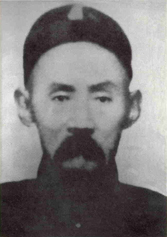 Yin Fu (Dec. 5, 1841- June 28, 1909) was Dong Haichuan's first and most accomplished student. Yin spent a great deal of time with Dong, including ten years working alongside him in Inner Mongolia making collections for Prince Su. After Dong Haichuan's death, Yin Fu took on many students of his own. These students included, importantly, some eunuchs who worked in the Forbidden City. One of these eunuchs, surnamed Qiu, was a personal attendant of the Emperor. One day, Yin Fu was in the Forbidden City teaching Qiu and Emperor Guangxu saw and came over to inquire about what they were practicing. Yin Fu told him it was Bagua and Guangxu said he would like to learn it. In this way, he became the martial art teacher for Emperor Guangxu.
Yin Fu (Dec. 5, 1841- June 28, 1909) was Dong Haichuan's first and most accomplished student. Yin spent a great deal of time with Dong, including ten years working alongside him in Inner Mongolia making collections for Prince Su. After Dong Haichuan's death, Yin Fu took on many students of his own. These students included, importantly, some eunuchs who worked in the Forbidden City. One of these eunuchs, surnamed Qiu, was a personal attendant of the Emperor. One day, Yin Fu was in the Forbidden City teaching Qiu and Emperor Guangxu saw and came over to inquire about what they were practicing. Yin Fu told him it was Bagua and Guangxu said he would like to learn it. In this way, he became the martial art teacher for Emperor Guangxu.
During the Boxer Rebellion of 1900, the Emperor was forced to flee the Forbidden City as troops from the Eight-Nation Alliance marched on Beijing to relieve the legations which had been seiged by rebels. Guangxu had Yin Fu accompany him as his personal bodyguard during the flight out of the capital to Chang'an. Yin stayed with the emperor in Chang'an for an entire year, until the royal family was able to return safely to Beijing in January of 1902. Upon their return, Guangxu gave Yin several gifts and asked him to stay on in the Forbidden City, working as an official. Yin stayed until Guangxu passed away in 1908. Yin Fu's students began referring to the unique flavor of Bagua he taught, being distinct from and more complete than that of Dong Haichuan's other students, as "Yin Style Bagua" after his passing in 1909.
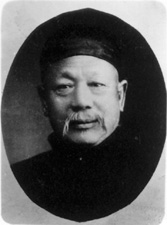 Men Baozhen (1872-1957) stood tall at 6'4" and was very strongly built. An imposing figure - indomitable, appearing larger-than-life, he was noted for his bagua lion palm sweeping, cutting, chopping, and hooking techniques which would rain down on opponents with great power. As a youth, Men didn't take an interest in his studies, preferring to train martial arts instead. He dilligently applied himself to his training, working hard practicing through the heat of summer and cold of winter. At about 20 years old, he met and began to study Baguazhang with Yin Fu, becoming one of Yin's top students. Men became a prominent figure in the East part of Beijing during the early Republic of China. During that time, Men Baozhen was asked to be a consultant to the famous Hebei Province Martial Arts Center. He had a number of notable students in Beijing, including his final student, Xie Peiqi.
Men Baozhen (1872-1957) stood tall at 6'4" and was very strongly built. An imposing figure - indomitable, appearing larger-than-life, he was noted for his bagua lion palm sweeping, cutting, chopping, and hooking techniques which would rain down on opponents with great power. As a youth, Men didn't take an interest in his studies, preferring to train martial arts instead. He dilligently applied himself to his training, working hard practicing through the heat of summer and cold of winter. At about 20 years old, he met and began to study Baguazhang with Yin Fu, becoming one of Yin's top students. Men became a prominent figure in the East part of Beijing during the early Republic of China. During that time, Men Baozhen was asked to be a consultant to the famous Hebei Province Martial Arts Center. He had a number of notable students in Beijing, including his final student, Xie Peiqi.
In 1935 Men Baozhen wrote the book "Orthodox Bagua", which is primary source material for much of the history written here.
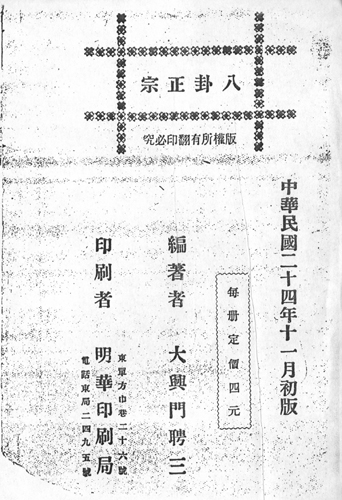
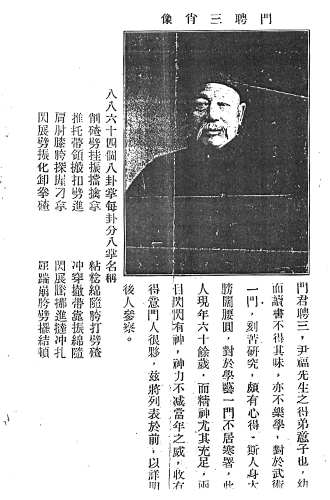
Dr. Xie Peiqi (1920-2003) began learning Tantui martial arts from his father as a youth and was a quick study. His family lived in Beijing next door to Men Baozhen and as the young Xie was well liked by Mr. Men, he had the opportunity to study Yin Style Bagua.
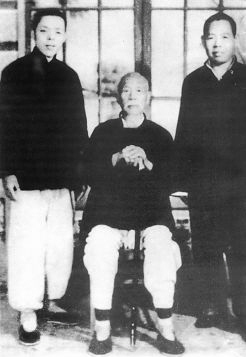
Unlike Men Baozhen, Xie Peiqi was not a tall or particularly strongly built man, but he worked hard and had talent. Under Men Baozhen’s instruction, Xie spent as much time as possible practicing and thinking over the art. He was intensive in his study of these skills and always glad to test them out in a fight. The techniques of lion, unicorn, dragon, snake, rooster, monkey, bear, and phoenix palms seeming to naturally well up from within him, all readily available at his fingertips. He could do as he pleased with his skills, all without breaking the rules of proper technique.
Xie had a great sense of humor; while teaching he would often show a wittiness that would have his students laughing out loud. While helping people to expand their knowledge and improve their skill, he exuded a unique charm. Whenever exchanging techniques with people, right after the hands had met and strikes would be ready to fall, the tip of his foot would already have arrived at the opponent’s throat. This kind of demonstration of the cold and clever style of his martial skill was always admired. Xie was also a fiercely loyal person with a heroic spirit and brave strength of character. All his life, he maintained great fighting spirit and athleticism.
Xie’s developed strength was profound; the characteristics of his strength were: heavy, solid, hard, crisp, full, and penetrating through. Heavy refers to a large amount of strength, solid means real, not empty, hard is strong and fierce, crisp denotes clean and agile, full means internal and external united - one part of the body issues strength, yet there is no part of the body that is not using strength. He could strike the front of your chest and you’d be sore all the way through to your back. Xie’s emitting of force was the result of a high degree of unity between his mind and body. Once, Xie attacked a man with a lifting palm and sent him flying up on top of a five and a half foot high water heater. This is one example out of many of his developed strength.
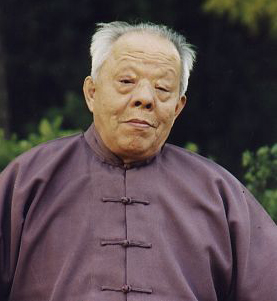 His techniques were clever yet practical, with a shrewd, ruthless flavor that was the ultimate unity of speed and strength. His fighting skill had speed and power that stood out in martial circles and his reputation for fast hands was well deserved. The essence of The Book of Changes, the inherent flexibility of bagua, the overall gist of martial arts - all these were in his mind and were able to be applied to his technique. Xie would always start his techniques from an unexpected place, with surprising speed and strength. He would show the left and attack the right, show high and attack low, show the front and attack the back. In Lao Tzu’s classic Daodejing, it is said that: "The Way produced one, one produced two, two produced three, and three produced all things." Each of Xie’s techniques had, at a minimum, three types of changes: techniques would rush forward, open across, or have a pulling back force; the lines of attack would be level (circles), straight up and down (circles), or angled (circles). Distance would be far, midrange, or close; stance height would be high, middle, or low. His body would move along with the technique, be straight upright, or move against the technique. His footwork would feature opening stepping, advancing stepping, or back stepping. Usually, the combinations of all these different types of changes were too numerous to mention. Start and finish were mutual, linked together and mutually producing, endlessly springing forth new, with inexhaustible changes, all according to the situation. Changes that acted alone, while also assisting other changes. Forcing and yielding, empty and full, fast and slow, real and feint, moving with and against, hard and soft - all types of changes. These palm changes were especially "cold" and would appear strange; keeping the opponent occupied and unable to keep up with what was going on, thereby being unable to defend himself. In that instant, victory and defeat would already be decided.
His techniques were clever yet practical, with a shrewd, ruthless flavor that was the ultimate unity of speed and strength. His fighting skill had speed and power that stood out in martial circles and his reputation for fast hands was well deserved. The essence of The Book of Changes, the inherent flexibility of bagua, the overall gist of martial arts - all these were in his mind and were able to be applied to his technique. Xie would always start his techniques from an unexpected place, with surprising speed and strength. He would show the left and attack the right, show high and attack low, show the front and attack the back. In Lao Tzu’s classic Daodejing, it is said that: "The Way produced one, one produced two, two produced three, and three produced all things." Each of Xie’s techniques had, at a minimum, three types of changes: techniques would rush forward, open across, or have a pulling back force; the lines of attack would be level (circles), straight up and down (circles), or angled (circles). Distance would be far, midrange, or close; stance height would be high, middle, or low. His body would move along with the technique, be straight upright, or move against the technique. His footwork would feature opening stepping, advancing stepping, or back stepping. Usually, the combinations of all these different types of changes were too numerous to mention. Start and finish were mutual, linked together and mutually producing, endlessly springing forth new, with inexhaustible changes, all according to the situation. Changes that acted alone, while also assisting other changes. Forcing and yielding, empty and full, fast and slow, real and feint, moving with and against, hard and soft - all types of changes. These palm changes were especially "cold" and would appear strange; keeping the opponent occupied and unable to keep up with what was going on, thereby being unable to defend himself. In that instant, victory and defeat would already be decided.
Xie had undergone a long period of bitter hard practice; all parts of his body were different from ordinary men. His palm, fingers, fists, wrists, shoulders, elbows, knees, hips, head, back, waist, and feet, all could be used in attack. When facing an opponent, Xie would always attack first, taking the first opportunity, with a high degree of mental concentration, never underestimating his opponent. Facing a rabbit no less seriously than he would a lion, with all of his strength rushing forth. It is certainly no accident that when testing his skill he was never defeated. Because each part of his body could execute very difficult techniques while fighting, he would always use the part of his body that was closest to the opponent to attack, trying his best to shorten the distance a technique would have to travel. His techniques were direct and to the point, with no superfluous movement, always trying to take the shortest path to attack. In this way his speed was extremely fast, and he was able to win his fights in a flash.
Xie’s bagua methods took strength, speed, and change and fused them together. To a layman’s eyes, Xie’s technique did not look pretty. But an expert could watch him and find endless subtleties to ponder. His use of hands, eyes, body, waist, and footwork was carried out with very particular attention to detail. At the moment of combat, his expression, positioning, and technique were all very much soundly in accord with the rules of the art.
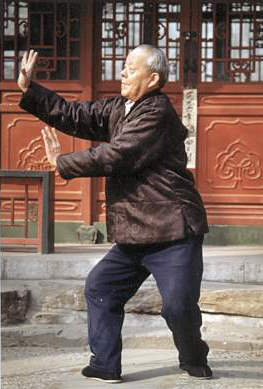 He would always have an air of authority while applying technique. There was an endless amount to learn from him and he would cause people to think over his methods to no end. Xie was meticulous in his practice; he was able to take the long accumulation of Chinese culture and thought and express these things to people through his art. He had arrived at the point of complete unity with Yin Style Bagua. In his techniques, one could see his deep love of Chinese martial arts.
He would always have an air of authority while applying technique. There was an endless amount to learn from him and he would cause people to think over his methods to no end. Xie was meticulous in his practice; he was able to take the long accumulation of Chinese culture and thought and express these things to people through his art. He had arrived at the point of complete unity with Yin Style Bagua. In his techniques, one could see his deep love of Chinese martial arts.
Xie Peiqi put a lifetime of experience, profound thought, and abundant effort into Yin Style Bagua. He was thus able to achieve a high level of skill, and contribute immensely to this art.
